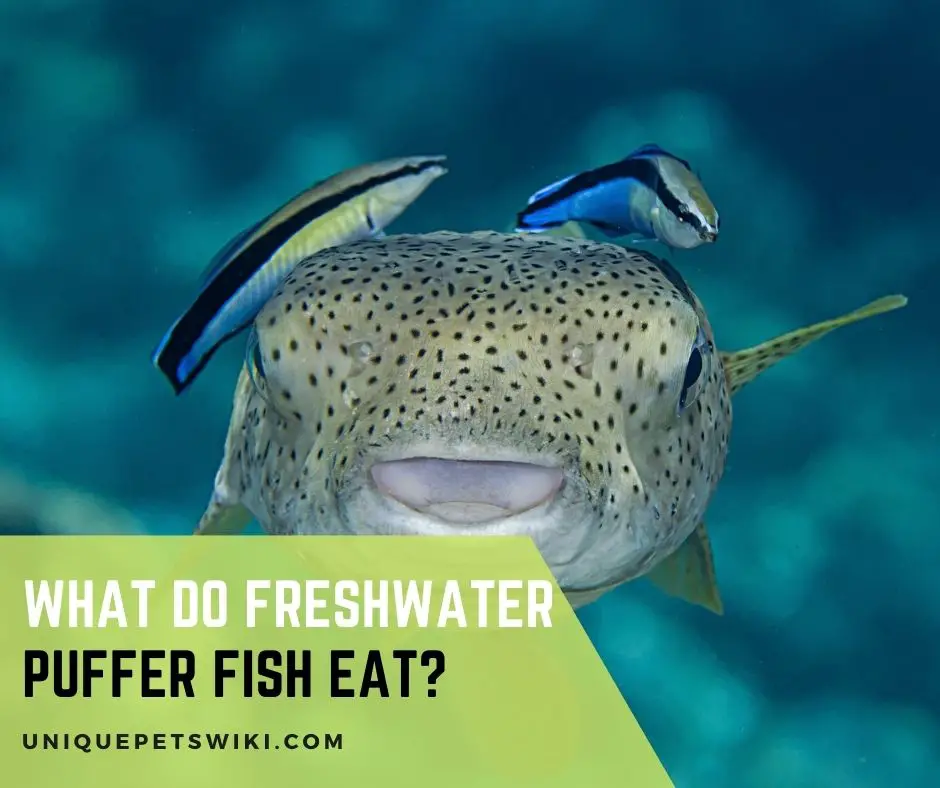It’s interesting how freshwater puffer fish are easy to keep, yet many owners still make a whole mess with it, especially in its water quality and dietary needs.
Many owners see the need to research what freshwater puffer fish eat only when they seem to have tried different options with less results.
Freshwater puffer fish eat a wide variety of both plant matter (algae) and animal protein. In the wild, freshwater puffer fish fry and juveniles tend to eat more algae and other little insects, worms, and larvae.
As they grow older and become bigger, they become carnivorous – eating primarily a meaty diet.
Therefore, to keep your freshwater puffer fish healthy in captivity, you must replicate its wild diet in captivity by feeding it live meaty foods.
These include snails, clams, crabs, corals, crayfish, krill, shrimp, and other types of crustaceans.
If you have a bigger puffer in your tank, you will have to feed it hard-shelled foods quite often to help trim down its ever-growing teeth.
Note that frozen-thawed and dried foods can be fed alongside live foods. But they should form the best part of your puffer’s diet. Pellets and flakes seem to be the ideal foods for some fish species, but are they ideal for puffer fish?
Let’s get into the article in detail to learn what freshwater puffer fish eat and how to feed them.
Contents
What Do Freshwater Puffer Fish Eat?
Depending on the species, freshwater puffer fish eat a variety of animal and plant-based food.
Despite the fact that freshwater Puffer fish are omnivores, they prefer a meat-based diet. They eat snails, clams, crustaceans, and other fish in the wild.
Algae account for roughly 20% of their diet, while protein-rich foods account for the other 80%. When freshwater puffer fish are young, they eat more algae. You can feed them live, frozen, and dried meat in captivity.
Keep in mind, however, that what you feed your pet puffer fish depends on its species and type. You should feed your puffer fish a diversified diet that meets their nutritional requirements.
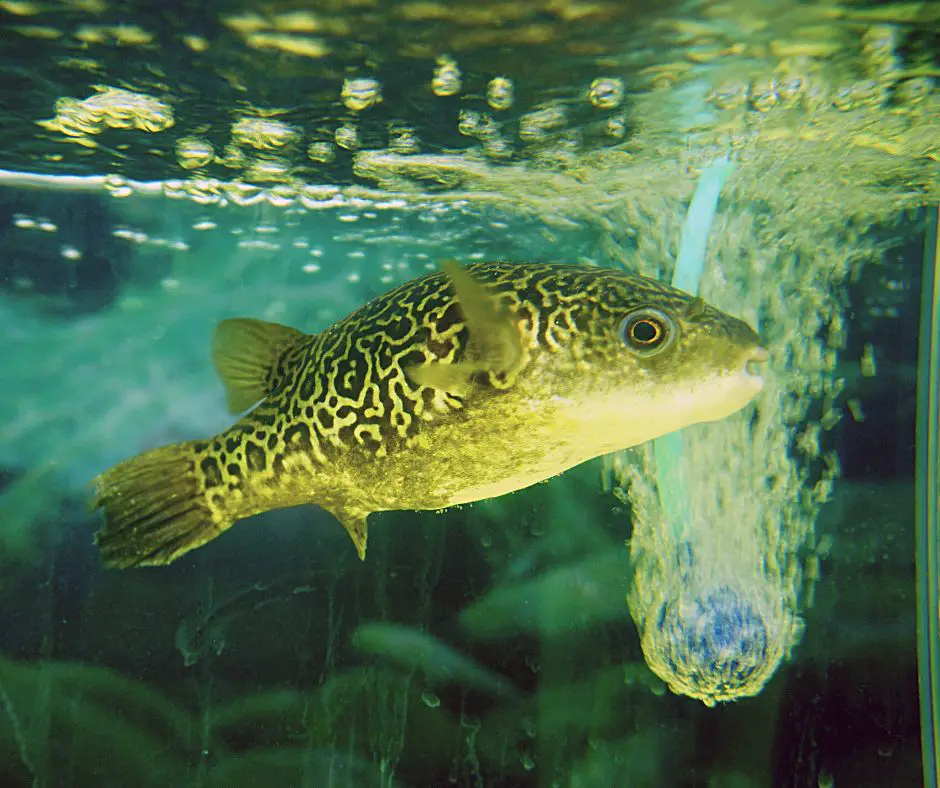
Live Food
In their natural habitat, freshwater puffer fish eat invertebrates like snails, mussels, and crustaceans. In fact, they’ll consume everything alive or dead that’s in the tank or that you offer them.
These include bloodworms, krill, shrimp, algae wafers, various whitebait fish, chopped squid, and hard-shelled organisms such as aquatic snails, clams, coral, and crabs.
Hard-shelled foods help to keep their teeth from becoming too large as they grow.
You should feed them live food as their primary source of nutrition. Because live foods have the greatest nutrients, they are the best choice for your puffer.
However, if you’re feeding it a ghost shrimp, you should consider feeding the shrimp vegetation so your puffers can get the nutrients when they eat them.
Note that for the health of your puffer, live foods should be fed more often than pellets, freeze-dried, and frozen-thawed foods.
Tetra JumboKrill Freeze-Dried Jumbo Shrimp 3.5 Ounces
- aquarium DIET SUPPLEMENT Natural shrimp treat designed to supplement any Tetra staple diet foods such as TetraMin Flakes
- FOR FRESHWATER & SALTWATER FISH Premium-quality nutritious supplement provides variety to your fish’s diet
- AIDS DIGESTION Complete freeze-dried krill with shells are an excellent source of roughage to support digestion
- COLOR ENHANCING Astaxanthin a natural color enhancer helps bring out the natural pink orange and red colors of fish
- USAGE Feed 2 to 3 times a week in addition to staple diet only as much as your fish can consume within a few minutes
Last update on 2022-12-29 / Affiliate links / Images from Amazon Product Advertising API
Dried, or Frozen Food
Frozen-thawed and dried foods are lifesavers. Besides feeding them together with live foods, they come in handy when live foods are not readily available.
You can feed smaller frozen fish, such as whitebait fish or lancetfish to your larger freshwater puffers.
Other foods you can feed frozen or dried are crabs, krill, king prawns, mussels, cockles, prawns, black worms, bloodworms, etc. However, keep in mind that frozen or dried foods shouldn’t become a regular meal for your puffers.
Fluval Bug Bites Tropical Fish Food
- Tropical fish food that contains up to 40%, nutrient-rich Black Soldier Fly Larvae, the first ingredient
- High in multiple proteins like whole salmon – rich in Omega 3 and 6 for healthy skin, scales and fins
- Fortified with essential vitamins, amino acids and minerals for a balanced daily diet
- Slow sinking micro granule format (0.7-1mm) – all fish can feed at their preferred depth; feed as much as fish can eat in two minutes, two or three times daily
- Sustainably processed in small batches for quality control and maximum freshness
Last update on 2022-12-29 / Affiliate links / Images from Amazon Product Advertising API
Pellets, Flakes, or Gel Foods
Pellets, flakes, and gel foods don’t seem to be the kind of food that puffers enjoy. Some puffer species such as fahaka puffers will occasionally eat them while other species generally wouldn’t accept them.
Species that’ll not eat flakes and pellets are spotted puffer fish, pea puffer, and many other species. However, even if your puffer accepts pellets and fish flake, do not make these foods the main part of their diet.
Tetra 77063 TetraCichlid Floating Pellets
- CICHLID FORMULATION Hearty floating pellets for use as a staple food for top- and mid-water-feeding cichlids
- FLOATING PELLETS Scientifically developed protein-rich cichlid food – natural color enhancer works to bring out the color of your fish
- FOR DAILY FEEDING Nutritionally balanced diet – maintains vitality and enhances fish’s natural beauty
- PROCARE FORMULA Helps support fish’s immune system for optimal health and long life
- CLEAR-WATER FORMULA Will not cloud water when used as directed
Last update on 2022-12-29 / Affiliate links / Images from Amazon Product Advertising API
7 Common Freshwater Puffer Fish and Their Food
Interestingly, there are about 120 different species of puffer fish. But only a few, less than 50 species are popular and commonly kept in homes as pets.
These species are popular and are commonly kept as pets because they are easy to raise.
Their diet is simple to get and owners do not need to spend much effort to find food for them.
A few of these popular species are pea puffer, congo puffer, fahaka puffer, eyespot puffer, mbu puffer, Northern puffer fish, red-eyed puffer, red-tailed dwarf puffer, south american puffer, target puffer, and many others.
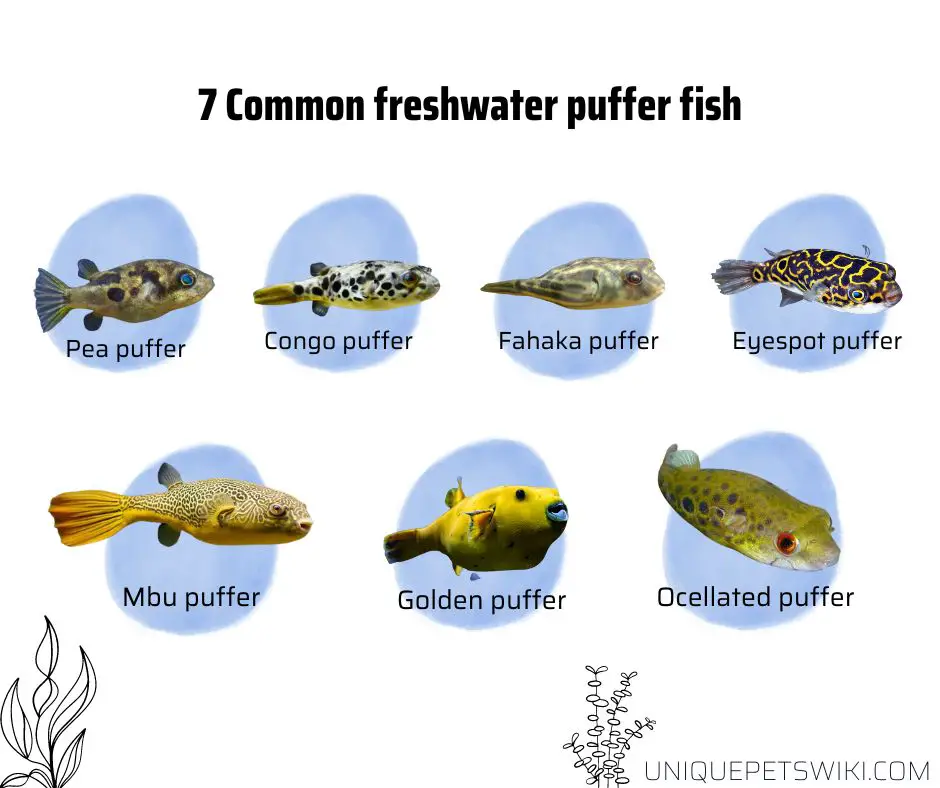
- Pea Puffer or Dwarf Puffer Fish
Pea puffers, like other puffer fish species, are carnivorous. In the wild, they eat insects, larvae, and other small invertebrates such as snails and brine shrimp to survive.
Bloodworms, blackworms, tiny snails, brine shrimp, glassworms, white worms, tubifex worms, krill, and other live or frozen items should be fed to them in captivity.
Pea Puffers do not require mollusks and most of them will not eat pellets in captivity.
- Congo Puffer
The Congo puffer fish is mostly a piscivore in the wild. This means that the majority of their diet consists of eating other fish.
They are also seen eating small freshwater crabs, crustaceans, shrimp, and other benthic invertebrates like worms in the wild.
Congo puffer fish in captivity may be slightly more difficult to care for than other species of freshwater puffer fish due to their unique diet.
With this in mind, you can feed your pet Congo puffer fish a diet of snails, shrimp, crabs, prawns, bloodworms, mussels, live or frozen-thawed worms, and other crustaceans.
Your Congo puffer will occasionally eat large ramshorn snails, Malaysian trumpet snails, pond snails, and other pest snails. But they might not accept pellets if fed to them.
Fahaka puffer fish is one other puffer species that have a diet similar to other puffer fish species. In the wild, they eat insects, mollusks, and crustaceans.
In captivity, you can feed them snails, shrimp, crabs, crayfish, and either live or frozen hard-shelled foods to keep down their growing teeth. You can also feed them freeze-dried krill.
- Eyespot Puffer or Figure 8 Puffer Fish
In the wild, eyespot puffer fish typically eat mollusks and crustaceans such as crabs, lobsters, shrimp, krill, and copepods.
In captivity, you must feed them meaty and hard-shelled foods such as snails, clams, crayfish, shrimp, crickets, plankton, daphnia, krill, scallops, oysters, and worms.
Avoid flake or dried foods as these do not meet their dietary needs.
- Mbu Puffer
This species of puffer fish are also known as the giant puffer fish because of their large size and teeth.
They feed primarily on shelled foods in the wild. These include mollusks, clams, crayfish, muscles, shellfish, snails, and other similar animals.
One of the reasons they prefer shelled foods to softer foods is because of their large growing teeth.
The hard-shelled foods will help trim down their teeth. Keeping this in mind, you can feed your giant puffer shelled foods 5 days a week and softer foods 2 days a week.
- Golden Puffer or Avocado Puffers
Golden puffers have a relatively wide variety of food in the wild. They eat shrimps, and occasionally whole fish.
In captivity, they are often fed live or frozen snails, bloodworms, gut-loaded shrimp, ghost shrimp, and sometimes seeds.
- Ocellated Puffer
Ocellated puffer fish do not do well with other fish as tank mates as they are very predatory. But both in the wild and in captivity, they have the same diet as other puffer species.
Other puffer species with a similar diet as the species mentioned above include red-tailed dwarf puffer, south American puffer, and target puffer.
How to Feed Freshwater Puffer Fish
It’s important to state that although puffer fish are omnivores, that is eating both algae and animal protein, they prefer a carnivorous/proteinous diet, especially when they are bigger.
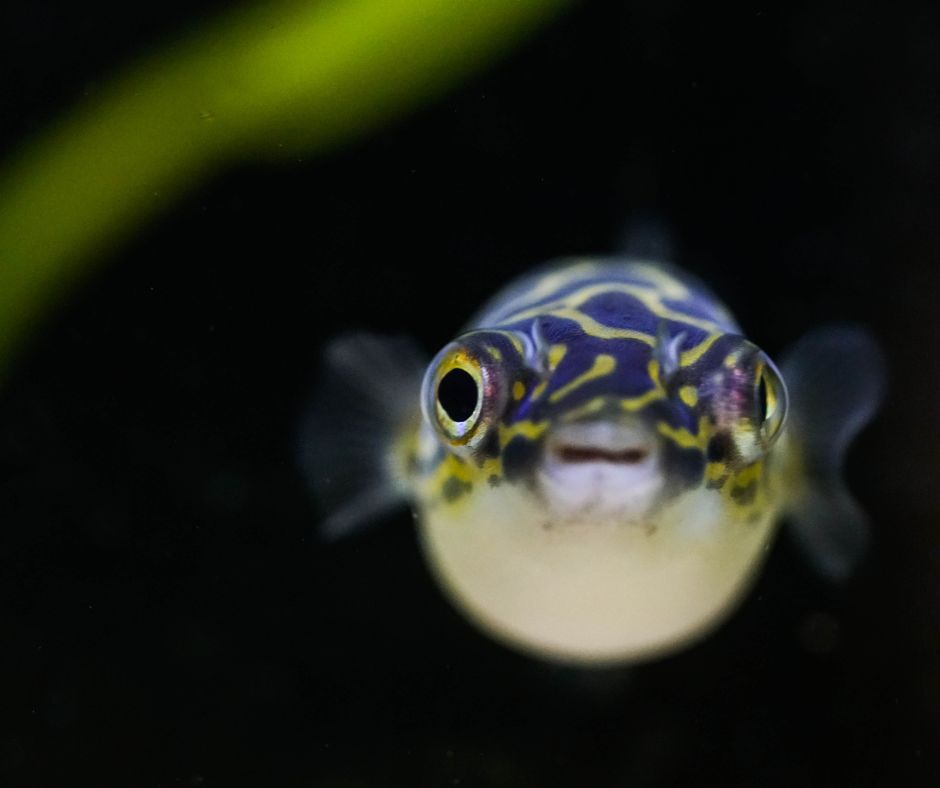
Foods captive puffer fish enjoy eating include snails, shellfish, clams, crustaceans, and a variety of worms such as bloodworms, California blackworms, tubifex worms, and white worms.
How to feed these foods to your freshwater puffers depends on the type of food. You do not feed live food with the same method you use when feeding freeze-dried or frozen food.
- For live foods such as snails, bloodworms, clams, shrimps, etc. suspend the food into the tank using a turkey baster or tongs. Watch as your puffer eats them and clean out uneaten food after each feeding to keep the tank clean.
Live foods should be quarantined, especially wild-caught. It is best if you raise the life feeder yourself in a separate tank.
This way, you can ensure that they don’t cause sickness to your puffers and the prey animals you have in the tank such as snails.
- For frozen foods, ensure you thaw them before feeding them to your puffers.
- Freeze-dried foods should be soaked to absorb some water before you offer them to your fish. Soaking the freeze-dried food will make the food soft and easy for your puffer to swallow.
2 Pieces Aquarium Feeder with 2 Pieces Stainless Steel Feeding Long
- Aquarium feeding set: the package includes 2 pieces coral feeder tubes in different sizes, easy to fit your different needs, and 2 pieces straight and curved tweezers, nice combination for feeding your little pets in the water; The stainless steel straight and curved tweezers can both feed and clean up the mess inside the fish tank
- Reliable material and easy to use: made of quality plastic and rubber material, the coral spot feeder is safe for fish and corals, clearly printed with 10ml, 15ml, 20ml, 30ml, 40ml and 50ml measurements for easy to read, ensuring that you know how much you are dispensing and prevents overfeeding; While the aquarium feeding tweezers are made of stainless steel with coating, durable and not easy to be rusted under water
- Long to keeps hands dry: the size of coral feeder is approx. 11.2 inch/ 28.5 cm, and the other one is approx 17.7 inch/ 45 cm long, helping you arrive at deep and hard-to-reach area, you can feed liquid food to corals, and the tweezers are approx. 10.62 inch/ 27 cm in length, they are good and practical tools for aquarium plants or reptiles
- Wide range of applications: you can feed liquid phytoplankton to corals or other aquatic animals by using coral feeder and tweezers, which is easy to control and prevents your hands from getting wet, these feeding tools can be applied in marine reef tank to feed coral, reef, anemones, lionfish, brine shrimp and so on for a long time
- Warm tips: please ensure that the coral feeder tube is washed and cleaned before use; Turn off your circulation pumps when feeding your coral or fish; After using the tweezer, please remember to rinse it with water and get it dried
Last update on 2022-12-30 / Affiliate links / Images from Amazon Product Advertising API
How Often Do You Feed Your Puffer Fish?
Puffer fish should be fed 1 – 2 times a day depending on the size and quantity of food you are feeding, and the size of the puffer fish. Smaller puffers under 2 inches should be fed daily.
Mid-size puffers, usually between 2 – 4 inches should be fed every other day.
Larger puffers measuring 4 inches and above should only be fed two or three times a week. Keep in mind that each feeding schedule should not exceed 5 minutes to avoid overfeeding.
How Much Do You Feed Your Puffer Fish?
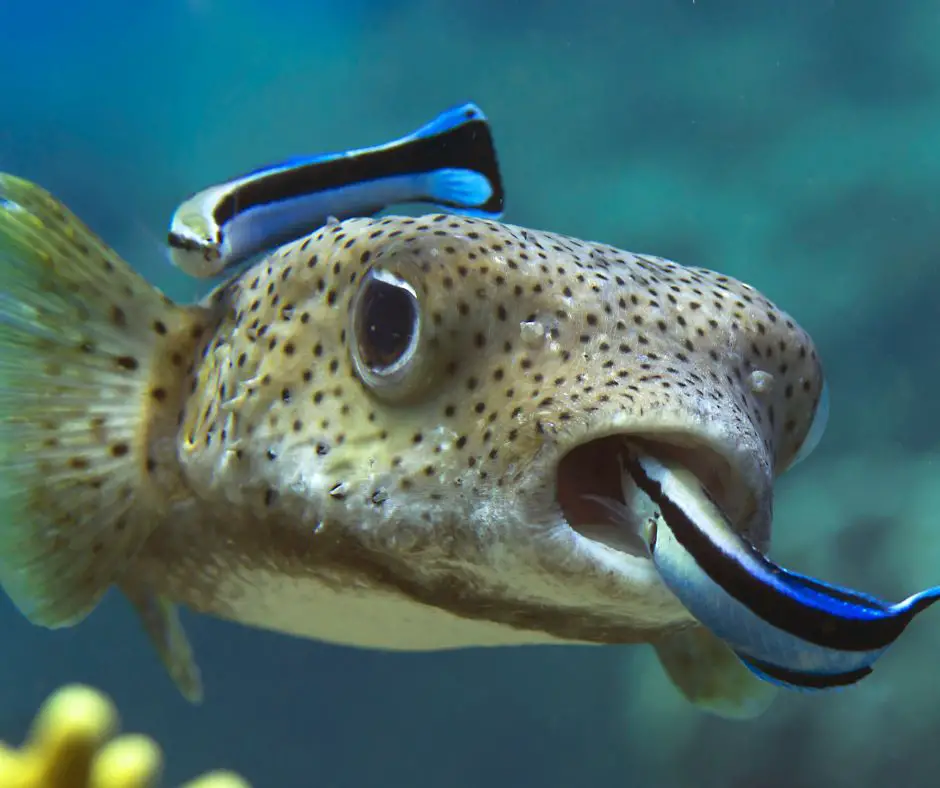
Puffer fish are heavy eaters that require food every day. Hence, how much you should feed your puffer fish is a reasonable amount of food 1 – 2 times a day, within 2 – 5 minutes.
How much you should feed your puffer fish also depends on the size of your puffer fish.
A small puffer fish of about 2 inches would only need 1 – 2 of either small snails, clams, mussels, shrimp, and krill a day or 4 – 5 live bloodworms or 1 cube of frozen bloodworms a day.
Bigger puffers would certainly need 1 – 2 extra food than what you are feeding the smaller ones a day.
During each feeding time, do not exceed 5 minutes. If after five minutes your puffer is still accepting food, it’s just a matter of time before your puffer will end up obese.
According to marine biologists, wild puffer fish eat mainly shelly foods which they consider poor quality because shelly foods contain very high amounts of ash which is indigestible.
So what happens in the wild is that puffer fish eat a good amount of these shelly foods, extract the nutrients they need and poop the indigestible stuff out.
Therefore, in captivity, a well-balanced puffer diet consists of snails, chopped squid, shrimp, clams, krill, carnivorous pellets, freeze-dried and frozen foods such as bloodworms.
Shelled foods such as mussels are also recommended to help wear down their continuously growing teeth, especially in bigger puffers.
Keep in mind that offering varieties is the key to ensuring proper nutritional balance in your puffers.
How Long Can Puffer Fish Go Without Eating?
Puffer fish can go without food for just a few days. This can take from 5 days and up to 2 weeks. One major factor that determines how long a puffer fish can go without food is its size.
The bigger a puffer fish is, the more resilient it is and can go from 10 days up to two weeks without food. The smaller puffer fish can only manage to go for 5 days without food before they die.
Conclusion
When puffer fish is mentioned, a lot comes to mind – their poisonous organs, aggressive personality, and the fact that they are illegal in some states. Many wouldn’t believe that puffer fish are easy to keep.
Yes, some species of freshwater puffer fish are quite easy to keep as pets. They are less aggressive, have a simple dietary needs, and can do well in tanks with other small animals.
These species include the pea puffer, Congo puffer, Northern puffer, figure 8 puffer, mbu puffer, golden puffer, and many others.
These puffer fish are carnivores and will do well on a diet of snails, clams, king prawns, crabs, shellfish, mussels, cockles, black worms, bloodworms, etc.
They will accept frozen and dried foods as well, but don’t make it a major part of their diet.
